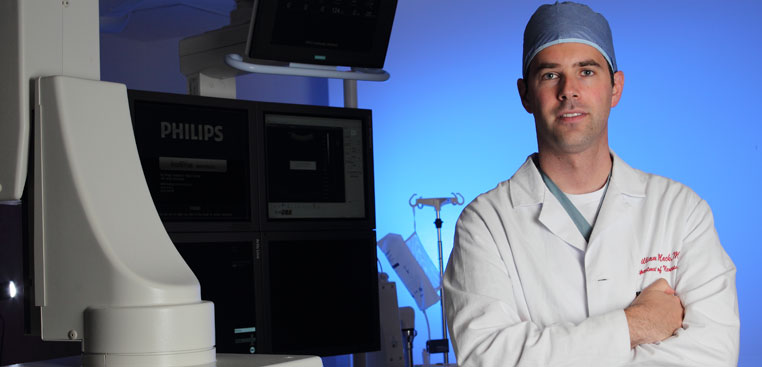USC Neurosurgeon Pioneers New Method to Deliver Brain-Protective Medicines During Stroke Procedures
In a study funded by the American Heart Association, researcher William Mack, MD, showed that catheters used to remove blood clots can also be used to send neuroprotective agents directly to affected brain areas.
For much of the last 20 years, immediate treatment for ischemic stroke has focused on the clot-busting drug tPA (tissue plasminogen activator.) But recently, the bulk of research has driven a shift to mechanical thrombectomy—the use of purpose-designed catheters, threaded into the brain through the femoral artery, to grab and pull out the clots that block blood vessels.

William Mack, MD
But the clock is always ticking in the race to restore healthy blood flow within the brain, so surgeons also use various neuroprotective strategies to minimize ischemic damage, such as targeted hypothermia and various chemical agents, including anti-inflammatory therapies and vasodilators. These protective agents have traditionally been administered intravenously, which means the medicines had to travel from the injection point to the stroke site in the brain.
William Mack, MD, Associate Professor of Neurological Surgery at Keck School of Medicine of USC, and Director of the Neurointerventional Program at Keck Hospital of USC, was an early adopter of mechanical thrombectomy. He saw that the catheters used to pull blood clots out of blood vessels could have an additional function as a drug-delivery system.
"Our thought was that while extracting the clot, it would be better to deliver these neuroprotective agents right to the affected area of the brain using the same tools we're using to remove the thrombus," said Mack.
The new delivery method could have important advantages over traditional IV injection. "Depending on the protective agent, it might allow the use of a higher effective dose without systemic side effects, or a smaller but equally effective dose," Mack said.
The research trial, which ran from 2013-2015, tested the neuroprotective agent magnesium, but the study's real goal was to understand if the catheters could be a safe and effective drug-delivery platform—one that might be useful for many types of interventions, in addition to stroke treatment. "We successfully demonstrated that we were able to deliver the agents with no additional side effects or problems," said Mack.
Mack is also an alum of the Southern California Clinical and Translational Science Institute's (SC CTSI) Mentored Career Development in Clinical and Translational Science Program (formerly known as the KL2.) The program is designed to improve and accelerate the progress of newer scientists and junior faculty toward careers as principal investigators in clinical and translational research. The SC CTSI also provides many types of support and services to health investigators throughout the USC and CHLA research community, and across Southern California, several of which played a role in Mack's study.
For example, consultants affiliated with the SC CTSI provided guidance with the complexities of regulatory science, including stringent FDA and other requirements. The SC CTSI works closely with the International Center for Regulatory Science, of the USC School of Pharmacy.
SC CTSI and regulatory science consultants helped set up the trial site and conducted trial site visits, and functioned as a clinical auditing team for the study. They put the proper regulatory forms in place, oversaw the stock and handling of the study drug, and ensured that all regulatory accounting was performed properly, Mack explained.
The clinical auditing team made periodic site visits to monitor the study's progress and recently performed final auditing visits and drafted the close-out report. The project is now completed with full regulatory compliance.
"The requirements of setting up and managing a clinical site and of handling the regulatory elements of clinical research are extremely complex and must be adhered to, both for the safety of the participants, but also to protect the research study itself," said Mack. "The help that the SC CTSI team offers investigators like me helps ensure that all these investments of time, money, and effort leads to the most valuable outcomes for the investigators and the investigation."



